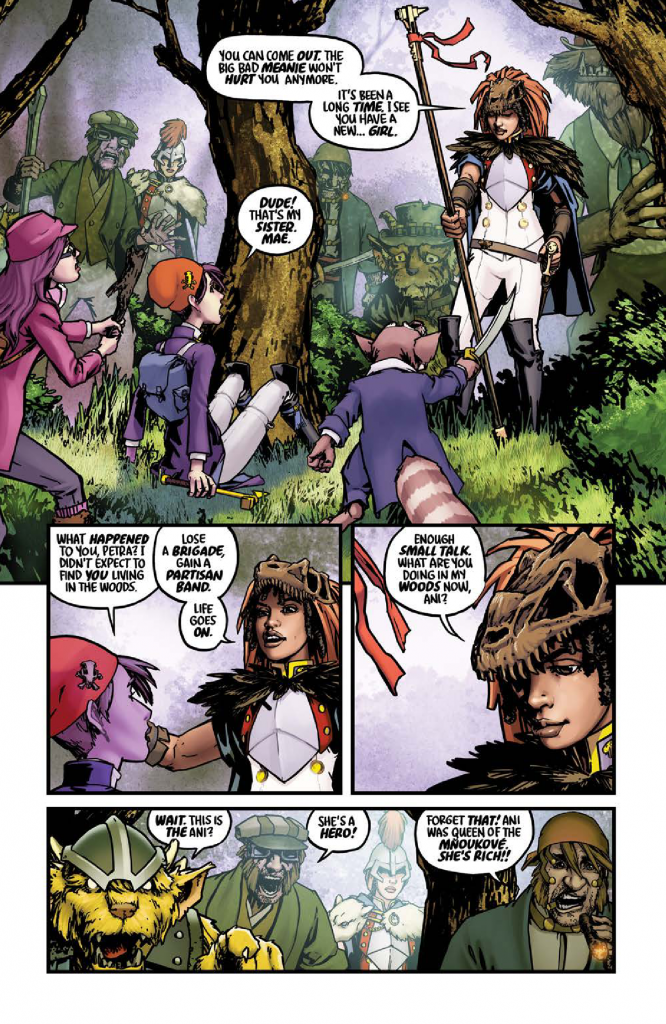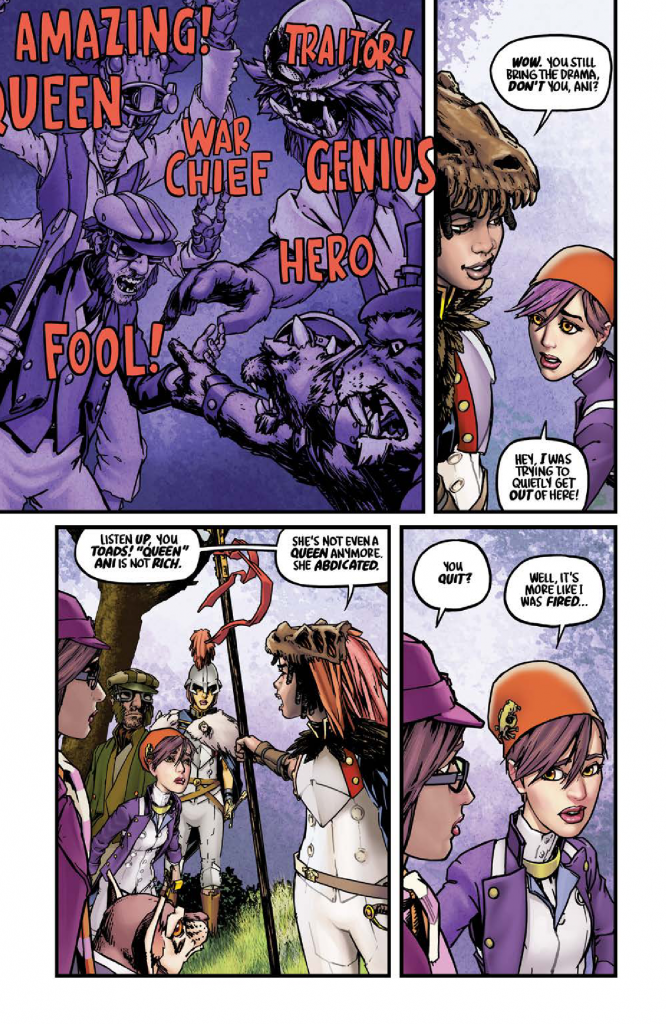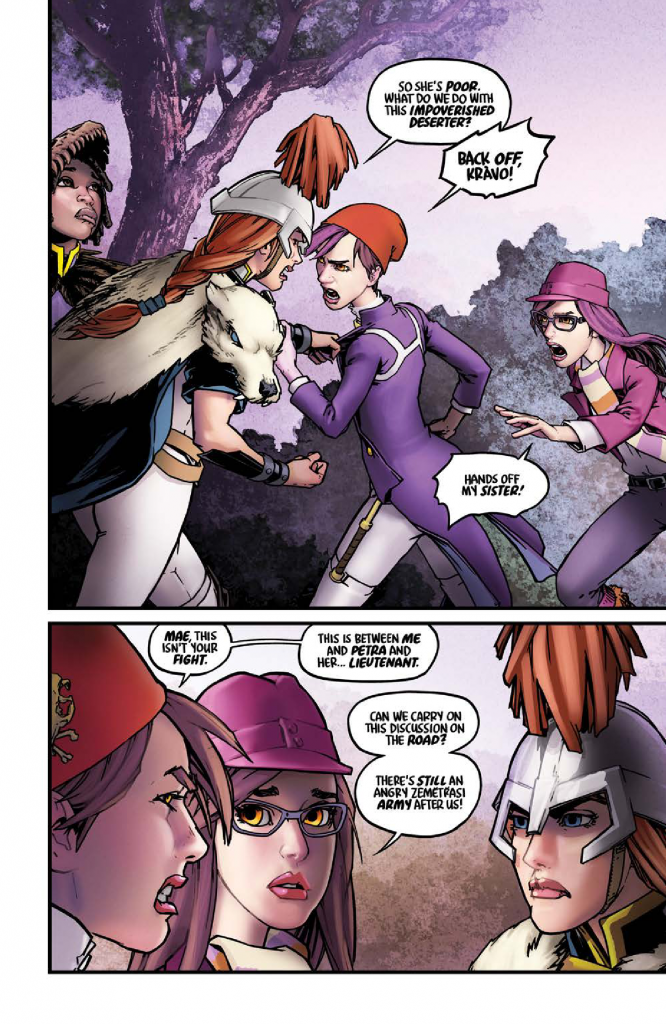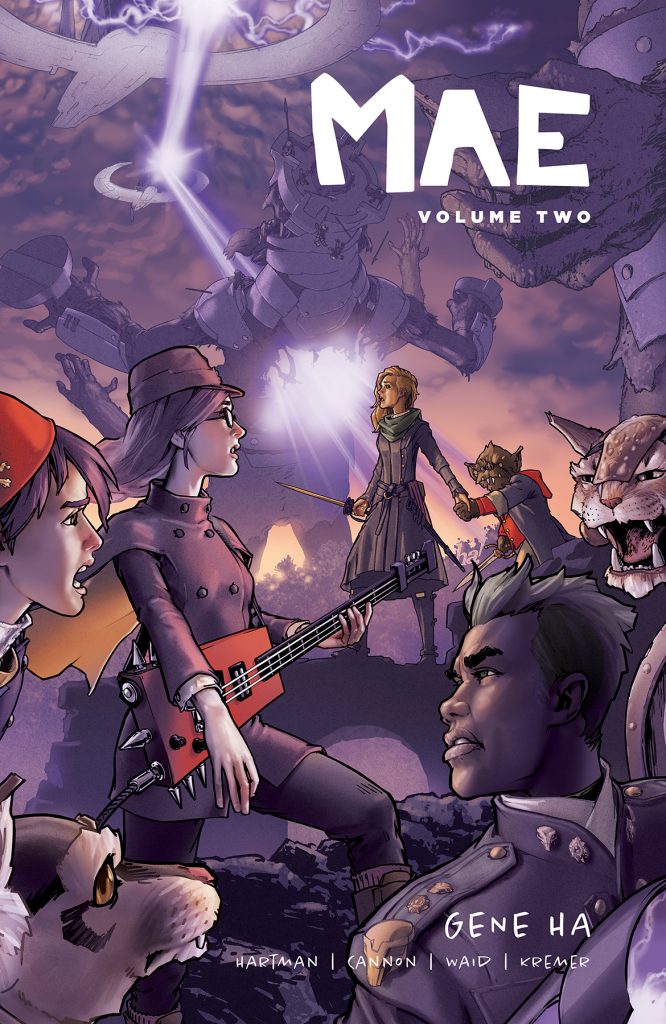by Jarrod Jones. Mae is fantastic worlds and the people who thrive there, an adventure rife with surprise, creativity, excitement; imbued with humanity and humility, Mae is a story that pushes the very boundaries of imagination and welcomes readers from all walks of life with open arms. It’s love, put on the page with zeal by an artist whose technical proficiency is awe-inspiring. To say that Mae is the ultimate entry in the storied career of Gene Ha is to indulge in understatement. Mae is a treasure. A wonder.
As a comic series, Mae has endured the tumultuous sea of an ever-changing industry by keeping its heart fixed to true north. From Dark Horse Comics to Lion Forge, and now a part of the new Lion Forge/Oni Press dichotomy, Mae endures because its captain is nimble, shrewd, adaptable, indefatigable. Gene Ha knows how to navigate comics’ choppier waves, knows how to bring his craft ashore safely by remaining true to his own creative spirit. As an endeavor, Mae is powerful. As a portal for new, curious readers, Mae is all-inclusive. Mae is for everyone.
Gene’s success stems from his awareness of the needs of readers, an ever-expanding audience with expectations and preferences as diverse as our lives and backgrounds. As the comics market has shifted, so too has Gene. “When I started in comics in the 90s and 00s, comics had given up on young readers,” he tells me. “I want to help draw them back in, whether through comic shops or libraries or bookstores. Lion Forge had the staff and skills to reach kids through all of those venues. I’ve never worked with a company like that before.”
As for the story of Mae, which will see its second story arc bound in a collected volume this September (details below), Gene has also expanded the scope of his narrative by adding to his creative team; Volume 2 of Mae is populated with both comics veterans such as Mark Waid and Zander Cannon and comics beginners like writer Molly Jane Kremer. These voices bring variety to Mae, bring unexpected but wholly welcome perspectives to Gene Ha’s wondrous creation. Which is consistent with Gene’s career philosophy: “Find your stories by being curious about your own world.”
DoomRocket spoke with Gene Ha about the second volume of his creator-owned series Mae, the expanding scope of his story, and how he brings in new voices to help shape its future.
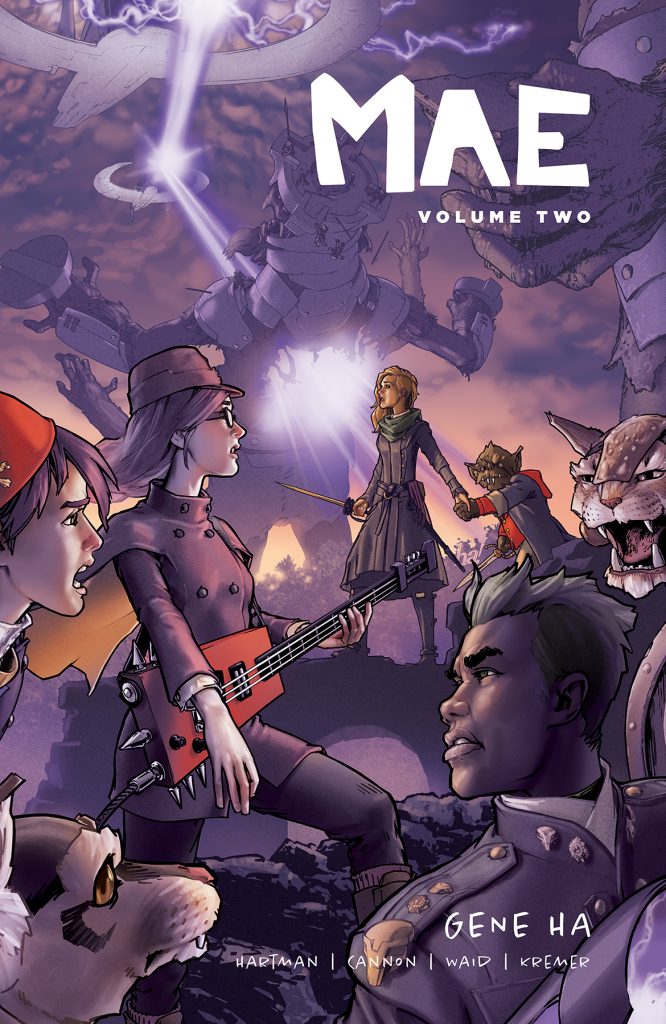
1. When we first met, you were working on the Kickstarter for the first volume of ‘Mae’, and one of the first things you made me read for context was Kyle Baker’s ‘Why I Hate Saturn’. Can you tell our readers a bit about why you love this story so much and how it lit a fuse in your mind that led to the creative explosion that is ‘Mae’?
Gene Ha: Why I Hate Saturn upended my expectations for a comic book. Kyle Baker chose two female leads who weren’t superheroes. Anne is a viciously brilliant magazine columnist, a slob, and a functional alcoholic. Her sister Laura claims to be the Queen of the Leather Astro-Girls of Saturn. It’s absurdist, but also astutely observed. Baker mocks our world by describing it accurately, then nudging it into satire and fantasy. He found stories by digging into the absurdity of real people. It’s a great lesson: find your stories by being curious about your own world.
[From Kyle Baker’s 1990 Eisner Award winning graphic novel, Why I Hate Saturn.]
2. The second collection of ‘Mae’ will be published in September. How has the story of ‘Mae’ evolved over this past run in terms of character? What’s the primary challenge of pulling in new readers as your story continues to expand, grow longer?
GH: Mae Fortell starts off as a supporting character in her own life, caring for her dad’s shop and his health. She’s afraid to take the lead when she follows her sister Abbie to another world, even if Abbie’s plans don’t make sense. In Volume 2, Mae is ready to go off on her own and chart her own course. For the first time in her life, Mae accepts that she can be the one to give orders and get angry and take a stand.
3. This second volume has brought Mae to the wondrous world of Cimrterén, where she discovers a bit of fame, fortune… and possibly romance. On the flip-side of this sisterly dichotomy, Abbie is blindsided with the sudden appearance of her former flame, which causes a rift between the Fortell sisters. It’s a great thing for narrative, to stir the pot this way, and agonizing for people who love seeing Mae and Abbie together. Why do you reckon romance, even the cooling embers of it, so utterly disrupts things for people?
GH: It’s not just romance, but all of our desires. The TV show Mad Men described the problem so: “In a nutshell, it all comes down to ‘What I want versus what’s expected of me.’” You’ll never please everyone, and trying to do the right thing can mean abandoning your dreams. Abbie couldn’t stay with her true love and be the hero Cimrterén wanted. Abbie’s decision will haunt her through Volume 2 and beyond. Mae will reunite with her boyfriend Colt in Volume 2 and he’s going to have a hard time believing her stories.
With its wondrous worlds, strange creatures, monolithic zeppelins and seasonally chic ‘Doctor Who’ scarves, sweeping romance seems a perfect fit for this kind of fantasy story. Will romance come to inform the overall narrative of ‘Mae’, or am I just getting wistful as I get older?
Mae and Abbie will each have romance, but that doesn’t lead to a “happily ever after” end to their problems. Finding true love isn’t a silver bullet to life’s struggles. The rest of the world will still make trouble, and you have to grow and adapt and listen to your love. Never take your beloved for granted.
4. Issue #9 of ‘Mae’ pulls back from Cimrterén for a bit of Midwestern intrigue viewed from the perspective of Mae’s friend, Dahlia. When you began working on the structure of this second arc, did you know you were going to zero in on a character-focused issue such as this?
GH: I knew that Mae would return to Indiana for a brief bit, and that Dahlia would follow Mae back to Cimrterén. The question arose: why was Dahlia ready to abandon college to join Mae? That led to a whole chapter at Purdue University. Dahlia’s giving up a lot to adventure in Cimrterén.
What is it about the mid-stream, done-in-one issue that appeals to you?
Inside of a longer story, it’s good to give the reader a break. It makes the big story arc deeper when you look at it from a different angle. In Mae Volume 2, Dahlia and Mae each get a solo issue. They don’t have Abbie’s super strength, but they have other talents to draw upon. When we return to the larger story, that growth allows them to take on the villains in Cimrterén.
5. You’ve said that ‘Mae’ was the story that you had to write yourself. But in this arc we see that you’ve had a bit of help in this regard courtesy of writers Mark Waid and Molly Jane Kremer, and there’s a short prequel story out there written by Danny Busiek. Tell me about why you chose these two writers for this arc, and what you learned about your characters by leasing them out to other creatives.
GH: I learned storytelling from tabletop roleplaying games, improv theater, and working with legendary comics writers. I love creative back-and-forth. I built the world of Mae and it’s fun to invite my friends to join me. Great collaborators inspire everyone to up their game. Danny Busiek was still in high school when they wrote about Mae’s high school days.
Mark Waid knows how to push a character out of their comfort zone and into fresh new adventures. I’ve often said I’d never write a scene where a cute boy takes off Mae’s glasses and says she’s beautiful. Mark wrote that story, and it’s brilliant in ways I never expected. Instead of negating Mae’s core nerdiness, Mark strengthened it.
Visually, Dahlia is based on DoomRocket writer Molly Jane Kremer. I didn’t know when I cast her that Molly Jane went to Purdue, just like Dahlia. I began basing Dahlia’s chapter on bits of Molly Jane’s actual time at Purdue. MJ also began giving me creative ideas. She was building my story for me, so I just asked her to write the issue. I couldn’t be happier with the script she gave me to draw.
6. You shifted the publication of ‘Mae’ from Dark Horse Comics to Lion Forge largely because Lion Forge had a crew with bookstore and library experience, and during your con hustle you make appearances at the American Library Association’s annual conference. What has reaching out beyond the direct comics market impacted ‘Mae’, and your overall perspective of the comics industry?
GH: When I started in comics in the 90s and 00s, comics had given up on young readers. I want to help draw them back in, whether through comic shops or libraries or bookstores. Lion Forge had the staff and skills to reach kids through all of those venues. I’ve never worked with a company like that before. Marvel and DC are just now building serious teams to serve those markets.
7. With the September 18 release of ‘Mae Vol. 2’ ‘Mae’ will officially have a third publisher attached to the book: Oni Press. Has the Lion Forge/Oni merger affected your book? What does this mean for the next wave of ‘Mae’ issues, when they come?
GH: “I’m just happy to be here. Hope I can help the ball club!” All joking aside, I’m excited to work with the new team in Portland. James Lucas Jones has reached out to me and answered any questions I have.
8. Among every amazing thing you’ve worked on over the years, you are technically a Vertigo veteran. While we’re talking, I wanted to get your perspective on the closing of Vertigo, the tightening grip on imprints across the industry, and what this holds for creator-owned output. I mean, folks are gonna make comics no matter who’s publishing them, but this does feel like a page has turned, doesn’t it?
GH: This door is finally shut, but it’s been inching closed for years. DC and Time/Warner want comics titles they control and can convert into movies and TV. They couldn’t compete with the creator owned deals offered by Image, or Oni, or book publishers like Scholastic and First Second. It took legendary editors like Karen Berger and Shelly Bond to keep Vertigo competitive. When DC fired Karen, and then Shelly, it was clear they planned to shut down Vertigo. Karen and Shelly are continuing the Vertigo we love at Berger Books and Black Crown, without the Vertigo trademark.
9. What do you have planned for the next year or so? What does the future hold for Gene Ha?
GH: I’ll be on the road promoting Mae. You can see my schedule on my website.
I’m taking a break to work on a short for Marvel, and do some long delayed home renovations. I’ll write the next arc of Mae, and might draw a graphic novel with a new writer. I wish I could say more!
10. You are a tremendous signal booster for new creative talent. Whose work has you excited these days? Who do you think will be making serious creative moves in the next couple years?
GH: I do love to signal boost, but it’s hard to predict who’ll be making great comics in two years and who’ll be working on a movie or video game instead. A great comics creator’s skills are useful in almost any visual or storytelling art. I’ll name a few exciting comics folks and trends.
I met Katie Cook 10 years ago at C2E2 and told her she was a genius. She was and is, and she’s making her best work yet on Nothing Special at Line Webtoon. That South Korean company is doing for web comics what YouTube did for online video: they’ve figured out a way to pay creators for making free online content. Also check out Monica Gallagher’s Assassin Roommate.
Eisner & McDuffie awards winner Christina “Steenz” Stewart is out at Lion Forge and cooking up new projects. I have no idea what she’ll do next, either as a creator or as an editor, but it’ll rock our world. She’s the single most multi-talented person I’ve ever met in comics. Editing, drawing, writing, public speaking, social media, comics, tabletop RPGs, she’s brilliant at it all.
Cook Korean by Robin Ha. I’m surprised there aren’t more foodie graphic novels. Robin joins the late Anthony Bourdain and Chicagoan Lucy Knisley in that field, and her work knocks it out of the park. Also, it’s nice having another Ha in comics.
Keep an eye on Travis McIntire, President and Editor-In-Chief of Michigan’s Source Point Press. There have been other Michigan comics publishers with a heavy metal soul, but Source Point Press is the best organized and most ambitious one I’ve seen. Those Hamilton lyrics come to mind: “Hey yo, I’m just like my country, I’m young, scrappy and hungry!” Check out Hope by Dirk Manning and K. Lynn Smith.
Newsprints by Xu Ru. She’s taking the diesel punk baton from predecessors like Legend of Korra and Dave Stevens’ Rocketeer, and making it fresh and exciting for kids. Her work is brilliantly idiosyncratic. As a small example, she knows mathematical perspective but she tweaks it in new ways to help the storytelling. I’ve never seen anything like it.
And keep an eye on the historical comics genre. Author Nathan Hale is mixing goofy wit into history, making it irresistible even if a kid doesn’t like history class. When more creators discover the hunger for fun history comics, it’s going to explode.
I need to stop. We’re in the second Golden Age of American Comics and there’s too much exciting work to list. I’ll finish with this: Raina Telgemeier’s Share Your Smile came out this year, a book of writing prompts and comic drawing advice. In eight years the wave of creators she just inspired will revolutionize comics again. Fifteen years ago I didn’t know if American comics had a future. Today, we are the future.
Gene Ha’s ‘Mae, Volume 2’ hits stores September 18. You can pre-order it now. (Diamond Code: JUL192046)
Check out this 5-page preview of ‘Mae, Volume 2’, courtesy of Lion Forge and Oni Press!
More comics interviews to get those synapses firing…
10 things concerning Aubrey Sitterson, Fico Ossio and the feels & ferocity of ‘No One Left to Fight’
10 things concerning Michelle Gish and the world of ‘We Are Here Forever’


![[From Kyle Baker's 1990 Eisner Award winning graphic novel, Why I Hate Saturn.]](https://doomrocket.com/wp-content/uploads/2019/07/Saturn-1-e1563217434761-676x1024.png)
![[From Kyle Baker's 1990 Eisner Award winning graphic novel, Why I Hate Saturn.]](https://doomrocket.com/wp-content/uploads/2019/07/Saturn-2-e1563217399528-676x1024.png)
![[From Kyle Baker's 1990 Eisner Award winning graphic novel, Why I Hate Saturn.]](https://doomrocket.com/wp-content/uploads/2019/07/Saturn-3-e1563217362282-678x1024.png)
![[From Kyle Baker's 1990 Eisner Award winning graphic novel, Why I Hate Saturn.]](https://doomrocket.com/wp-content/uploads/2019/07/Saturn-4-e1563217318497-676x1024.png)
